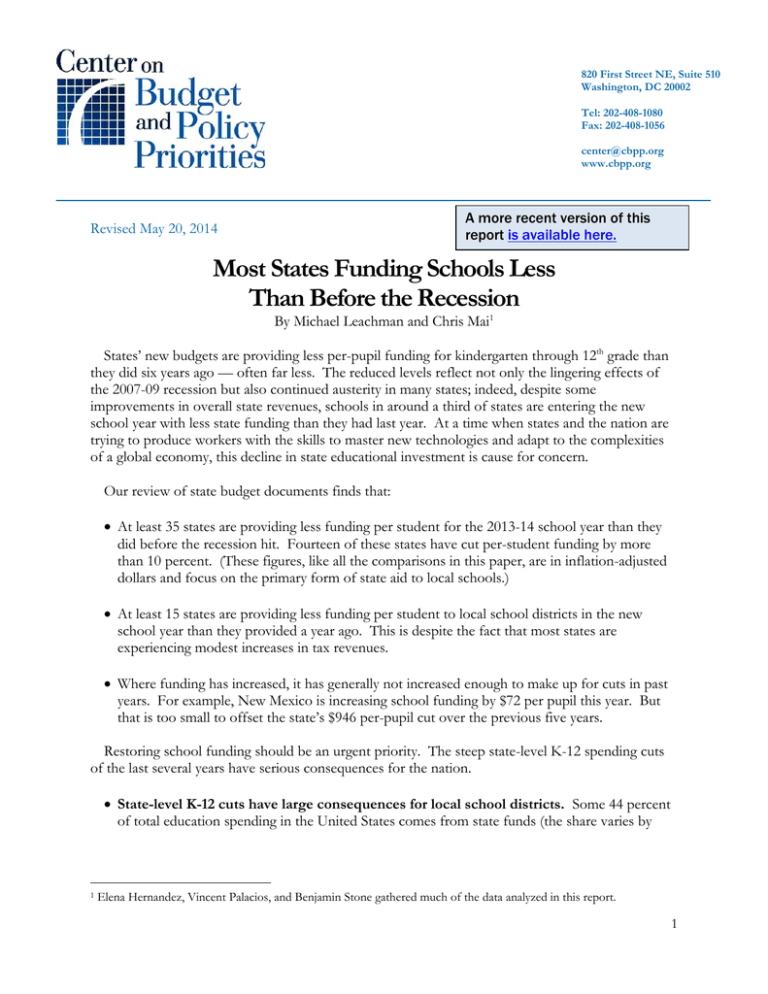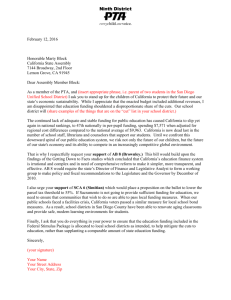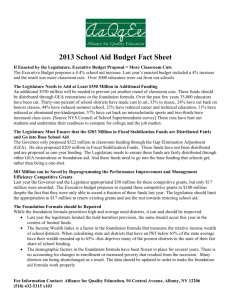Document 11669841
advertisement

820 First Street NE, Suite 510 Washington, DC 20002 Tel: 202-408-1080 Fax: 202-408-1056 center@cbpp.org www.cbpp.org A more recent version of this report is available here. Revised May 20, 2014 Most States Funding Schools Less Than Before the Recession By Michael Leachman and Chris Mai1 States’ new budgets are providing less per-pupil funding for kindergarten through 12th grade than they did six years ago — often far less. The reduced levels reflect not only the lingering effects of the 2007-09 recession but also continued austerity in many states; indeed, despite some improvements in overall state revenues, schools in around a third of states are entering the new school year with less state funding than they had last year. At a time when states and the nation are trying to produce workers with the skills to master new technologies and adapt to the complexities of a global economy, this decline in state educational investment is cause for concern. Our review of state budget documents finds that: At least 35 states are providing less funding per student for the 2013-14 school year than they did before the recession hit. Fourteen of these states have cut per-student funding by more than 10 percent. (These figures, like all the comparisons in this paper, are in inflation-adjusted dollars and focus on the primary form of state aid to local schools.) At least 15 states are providing less funding per student to local school districts in the new school year than they provided a year ago. This is despite the fact that most states are experiencing modest increases in tax revenues. Where funding has increased, it has generally not increased enough to make up for cuts in past years. For example, New Mexico is increasing school funding by $72 per pupil this year. But that is too small to offset the state’s $946 per-pupil cut over the previous five years. Restoring school funding should be an urgent priority. The steep state-level K-12 spending cuts of the last several years have serious consequences for the nation. State-level K-12 cuts have large consequences for local school districts. Some 44 percent of total education spending in the United States comes from state funds (the share varies by 1 Elena Hernandez, Vincent Palacios, and Benjamin Stone gathered much of the data analyzed in this report. 1 state).2 Cuts at the state level mean that local school districts have to either scale back the educational services they provide, raise more local tax revenue to cover the gap, or both. Figure 1 Per-Student Spending Remains More Than 10% Lower Than 2008 in 14 States Local school districts typically have little ability to replace lost state aid on their own. Given the still-weak state of many of the nation’s real estate markets, many school districts struggle to raise more money from the property tax without raising rates, and rate increases are often politically very difficult. Localities collected 2.1 percent less in property tax revenue in the 12-month period ending in March 2013 than in the previous year, after adjusting for inflation.3 The cuts deepened the recession and have slowed the economy’s recovery. Federal employment data show that school districts began reducing the overall number of teachers and other employees in July 2008, when the first round of budget cuts began taking effect. As of August 2013, local school districts had cut a total of 324,000 jobs since 2008.4 These job losses have reduced the purchasing power of workers’ families, in turn reducing overall economic consumption, and thus deepened the recession and slowed the pace of recovery. Sources: CBPP budget analysis and National Center for Education Statistics enrollment estimates. U.S. Census Bureau, Public Elementary-Secondary Education Finance Data, 2011 data, http://www.census.gov/govs/school/ 2 3 CBPP analysis of Census state and local quarterly tax data, http://www.census.gov/govs/qtax/ 4 Bureau of Labor Statistics, State and Metro Are Employment, Hours, & Earnings. http://www.bls.gov/sae/ 2 The cuts undermine education reform and hinder school districts’ ability to deliver highquality education, with longterm negative consequences for the nation’s economic competitiveness. Many states and school districts have undertaken important school reform initiatives to prepare children better for the future, but deep funding cuts hamper their ability to implement many of these reforms. At a time when producing workers with high-level technical and analytical skills is increasingly important to a country’s prosperity, large cuts in funding for basic education threaten to undermine the nation’s economic future. Figure 2 Dollars Spent Per Student Still Down In Most States Since 2008 States Have Cut K-12 Schools’ Primary Funding Source K-12 schools in every state rely heavily on state aid. On average, some 44 percent of total education expenditures in the United States come from state funds; the share varies by state. States typically distribute most of this funding through formulas that allocate money to school districts. Each state uses its own formula. Many states, for instance target at least some funds to districts that have higher levels of student need (e.g., more students from low-income families) Sources: CBPP budget analysis and National Center for Education Statistics enrollment estimates. and less ability to raise funds from local property taxes and other local revenues, although this targeting typically is insufficient to fully equalize educational expenditures across wealthy and poor school districts.5 See Bruce Baker, David Sciarra, and Danielle Farrie, Is School Funding Fair? A National Report Card, Second Edition, Education Law Center, June 2012, http://www.schoolfundingfairness.org/, and Richard Coley and Bruce Baker, Poverty and Education: Finding the Way Forward, ETS Center for Research on Human Capital and Education, July 2013, pp. 36-37, http://www.ets.org/s/research/pdf/poverty_and_education_report.pdf. 5 3 Figure 3 This substantial reliance on state aid means that cuts to state formula funding force local school districts either to scale back the educational services they provide, to raise more revenue to cover the gap, or both. 15 States Cut Per-Student Spending This Year In addition to the funding they distribute through general aid formulas, states may or may not use separate allocations to fund items such as pupil transportation, contributions to school employee pension plans, and teacher training. Those allocations typically are smaller than general aid funding. For 48 states, the necessary data are available to compare this year’s allocations for the first category of funding, general formula funding with funding before the recession hit.6 The 48 states included in this analysis are home to 97 percent of the nation’s schoolchildren. State K-12 Funding in the Current 2013-14 School Year Compared With 2007-08 States made widespread and very deep cuts to education formula funding since the start of the recession, and those cuts linger in most states. (See Figures 1 and 2.) This survey finds that, after adjusting for inflation: More than two-thirds of states — 35 of the 48 states analyzed — are providing less per-student funding for K-12 education in the current 2014 fiscal year than they did in Hawaii, Indiana, and Minnesota are excluded because the necessary data to make a valid comparison are not available. California is also excluded for reasons described in the methodological appendix. Sources: CBPP budget analysis and National Center for Education Statistics enrollment estimates. For the remaining two states, Indiana and Hawaii, education funding data are published in ways that make it difficult to make accurate historical comparisons. The District of Columbia is excluded because it is a city that operates a single school district with no distinction between state and local funding. See appendix for a detailed explanation of our methodology. 6 4 fiscal year 2008. In more than one-fourth of states, or 14 of the 48, per-student funding is 10 percent or more below pre-recession levels. Figure 4 Increases in Per-Student Spending This Year Don’t Fully Compensate for 2008-2013 Cuts The two states with the deepest cuts — Alabama and Oklahoma — each have reduced per-student funding by more than 20 percent from pre-recession levels. School Funding in 2013-14 Compared With 2012-13 Some states continued to cut their per-pupil school funding in the last year. These cuts generally have been modest, but they generally come on top of severe cuts in previous years, leaving state funding for schools far behind pre-recession levels. (See Figures 3 and 4.) In 15 states, per-student funding is lower in the current fiscal year (2014), than it was in the last fiscal year (2013), after adjusting for inflation. Other states increased funding for the current school year, but perpupil spending generally remains far below pre-recession levels. For example, New Mexico’s $72 per-pupil increase this year was not nearly enough to offset the state’s $946 per-pupil cut over the previous five years. Maine increased per-pupil funding by $68 in fiscal year 2014, an increase that pales in comparison to the $465 cut the state made between fiscal years 2008 and 2013. Hawaii, Indiana, and Minnesota are excluded because the necessary data to make a valid comparison are not available. California is also excluded for reasons described in the methodological appendix. Sources: CBPP budget analysis and National Center for Education Statistics enrollment estimates. 5 Why Have States Cut Funding So Deeply? States cut funding for K-12 education — and a range of other areas of spending including higher education, health care, and human services — as a result of the 2007-09 recession, which caused state revenue to fall sharply. Emergency fiscal aid from the federal government initially helped prevent even deeper cuts but it ran out before the economy had recovered, and states have disproportionately chosen to address their budget shortfalls through spending reductions rather than a more balanced mix of service cuts and revenue increases. Cuts are particularly deep when inflation and other cost pressures are considered. Revenues remain below pre-recession levels. The recession of 2007-09 and the slow recovery continue to affect state budgets and schools. Persistently high unemployment and continued low housing values have left people with both less income and purchasing power. So states continue to receive less income and sales tax revenue, which are the main sources of revenue states use to fund education and other services. State revenues are starting to improve across the country. State tax revenues grew 8.9 percent in the 12-month period ending in March 2013. But they remain 2.8 percent below 2008 levels after adjusting for inflation. Costs are rising. The costs of state-funded services have increased since the recession, due to inflation, demographic changes, and rising needs. For example, in the current school year, the U.S. Department of Education estimates that there are about 775,000 more K-12 students and 3.2 million more public college and university students than there were in 2007-08.7,8 Some 8.7 million more people are estimated to be eligible for Medicaid in 2013 than were enrolled in 2008, as employers have cancelled their coverage and people have lost jobs and wages.9 States have avoided raising new revenues. States have disproportionately relied on spending cuts to close the very large budget shortfalls they have faced over the last several years, rather than a more balanced mix of spending cuts and revenue increases. Between fiscal years 2008 and 2012, states closed 45 percent of their budget gaps through spending cuts, and only 16 percent of their budget gaps through taxes and fees (they closed the remainder of their shortfalls with federal aid, reserves, and various other measures).10 States could have lessened the cuts to education funding and made more progress in restoring the funding that has been lost if they had been more willing to raise additional revenue. Federal aid to states has fallen. States used emergency fiscal relief from the federal government (including both education aid and other forms of state fiscal relief) to cover a significant share of their shortfalls through the 2011 fiscal year. After the 2011 fiscal year, the federal government largely allowed this aid to expire, even though states continued to face very large shortfalls in 2012 and beyond. The expiration of most federal aid at the end of the 2011 7 National Center for Education Statistics, Projections of Education Statistics to 2021, Table 6. 8 National Center for Education Statistics, Digest of Education Statistics, 2012, Table 224. CBPP calculations based on data from the Congressional Budget Office and Centers for Medicare and Medicaid Services. 9 10 6 CBPP calculations. fiscal year is a key reason why state education funding dropped so sharply in the 2012 fiscal year and remains suspended at such low levels. Adding to states’ struggles, federal policymakers have cut ongoing federal funding for states and localities, thereby worsening state fiscal conditions. For example, since 2010, federal spending for Title I — the major federal assistance program for high-poverty schools — is down 12 percent after adjusting for inflation, and federal spending on disabled education is down 11 percent.11 These cuts include the automatic, across-the-board cuts known as “sequestration,” and the cuts required by the Budget Control Act of 2011.12 (See Figure 5.) K-12 Education Cuts Have Serious Consequences States’ large cuts in education spending have serious consequences for the economy, in both the short and long term. Local school districts typically have little ability to make up for lost state funding on their own. As a result, deep state funding Figure 5 cuts lead to job losses, slowing the economy’s recovery Major Federal Education Aid from the recession. Such cuts also counteract and sometimes undermine important state education reform Programs for States Have Been Cut initiatives at a time when producing workers with highlevel technical and analytical skills is increasingly important to a country’s prosperity. Local School Districts Hard Pressed to Make Up for Lost State Funding The precipitous decline in property values since the start of the recession, coupled with the political or legal difficulties in many localities of raising property taxes, make raising significant additional revenue through the property tax very difficult for school districts. Indeed, property tax collections were 2.1 percent lower in the 12month period ending in March 2013 than in the previous 12 months, after adjusting for inflation. Beyond increasing local revenues, school districts’ options for preserving investments in education services are very limited. Some localities could divert funds from other local services to shore up school district budgets, but this would sustain education spending at the expense of other critical services like police and fire protection. 11 *Title I funding supports K-12 education in school districts with high proportions of low-income families Source: CBPP calculations based on OMB data. CBPP analysis of data from the Office of Management and Budget. If the federal government takes additional measures to reduce the federal deficit that fail to raise new revenue, state aid likely would be cut further. For example, the House passed a deficit-reduction plan earlier this year that does not raise significant new revenue. That plan would produce cuts to state aid programs almost three times as deep as those imposed under sequestration. See Michael Leachman, et al. “Ryan Budget Would Shift Substantial Costs to States and Localities,” Center on Budget and Policy Priorities, March 27, 2013, http://www.cbpp.org/cms/index.cfm?fa=view&id=3942. 12 7 Undermining Education Reform State education cuts are counteracting and sometimes undermining reform initiatives that many states are undertaking with the federal government’s encouragement, such as supporting professional development to improve teacher quality, improving interventions for young children to heighten school readiness, and turning around the lowest-achieving schools. Deep cuts in state spending on education can limit or stymie education reform efforts by limiting the funds generally available to improve schools and by terminating specific reform initiatives. Reforms endangered by funding cuts include: Recruiting better teachers. Research suggests that teacher quality is the most important schoolbased determinant of student success.13 So recruiting, developing, and retaining high-quality teachers is essential to improving student achievement. These tasks are more difficult when school districts are cutting their budgets. Teacher salaries make up a large share of public education expenditures, so funding cuts inevitably restrict districts’ ability to expand teaching staffs and supplement wages. Trimming class size. Evidence suggests that smaller class sizes can boost achievement, especially in the early grades and for low-income students. Yet, small class sizes are difficult to sustain when schools are cutting teachers and enrollments are increasing. Indeed, a survey of school administrators found that 54 percent of respondents increased class sizes for the 201112 school year and 57 percent anticipated doing so for the 2012-13 school year.14 Expanded learning time. Many education policy experts believe that more student learning time can improve achievement.15 In a number of states and school districts, however, budget cuts are making it more difficult to extend instructional opportunities. For example, the Los Angeles and Philadelphia school districts have significantly scaled back their summer school programs.16 High-quality early education. Forty states provided pre-kindergarten or pre-school programs, which served 1.3 million children, in the 2011-12 school year.17 A number of studies conclude See for example, “Empowering Effective Teachers: Readiness for Reform,” Bill and Melinda Gates Foundation Research Brief, February 2010, http://www.gatesfoundation.org/united-states/Documents/empowering-effectiveteachers-readiness-for-reform.pdf. 13 Noelle M. Ellerson, American Association of School Administrators, Weathering the Storm: How the Economic Recession Continues to Impact School Districts, March 2012, p. 4. 14 See for example, Center for American Progress, “Expanded Learning Time By the Numbers,” April 22, 2010, http://www.americanprogress.org/issues/2010/04/elt_numbers.html. 15 See, for example: Jed Kim, “Students Feel Deep Cuts to L.A. Unified Summer School Program,” Southern California Public Radio, July 22, 2013,http://www.scpr.org/blogs/education/2013/07/22/14220/students-feel-deep-cuts-to-l-aunified-summer-scho/; Trip Gabriel, “Budget Cuts Reach Bone for Philadelphia Schools,” New York Times, June 16, 2013, http://www.nytimes.com/2013/06/17/education/budget-cuts-reach-bone-for-philadelphiaschools.html?pagewanted=all. 16 W. Steven Barnett, et. al., The State of Preschool 2012, National Institute for Early Education Research, p. 6, http://nieer.org/sites/nieer/files/2011yearbook.pdf. 17 8 that such programs can improve cognitive skills, especially for disadvantaged children.18 In the 2011-2012 school year, 27 of the 40 states that offered state-funded pre-K reduced the per-child funding amount. Sixteen states cut enrollment in pre-kindergarten programs, with an especially large reduction in North Carolina. Damage to the Economy, Now and in the Future State education budget cuts prolonged the recession and have slowed the pace of economic recovery by reducing overall economic activity. The spending cuts have caused school districts to lay off teachers and other Figure 6 employees, reduce pay for Four Years of School Job Cuts the education workers who remain, and cancel contracts with suppliers and other businesses. These steps remove consumer demand from the economy, which in turn discourages businesses from making new investments and hiring. Local school districts have eliminated 324,000 jobs nationally since July 2008, federal data show. (See Figure 6.) This decline has been unprecedented; normally, local education Sources: Bureau of Labor Statistics, seasonally adjusted data. employment grows each year to keep pace with an expanding student population. In addition, education spending cuts have cost an unknown but likely large number of additional jobs in the private sector as school districts have canceled or scaled back private-sector purchases and contracts (for instance, purchasing fewer textbooks). These job losses shrink the purchasing power of workers’ families, which in turn affects local businesses and slows recovery. In the long term, the savings from today’s cuts may cost states much more in diminished economic growth. To prosper, businesses require a well-educated workforce. The deep education spending cuts states have enacted will weaken that future workforce by diminishing the quality of elementary and high schools. At a time when the nation is trying to produce workers with the skills to master new technologies and adapt to the complexities of a global economy, large cuts in funding for basic education undermine a crucial building block for future prosperity. Ibid. See also Julia Isaacs, “State Research Brief #1: State Pre-Kindergarten,” Impacts of Early Childhood Programs, September 2008, http://www.brookings.edu/~/media/Files/rc/papers/2008/09_early_programs_isaacs/09_early_programs_brief1.pdf. 18 9 Appendix: Methodology The education funding totals presented in this paper reflect the funding distributed through states’ major education funding formulas. The numbers do not include any local property tax revenue or any other source of local funding. Additional adjustments were made to reflect the following state-specific policies or data limitations: California’s numbers reflect General Fund Proposition 98 spending for K-12 education. Since child care funding was removed from Proposition 98 spending in fiscal year 2012, it has been taken out of funding amounts for prior years to make them comparable. In November 2012, California voters enacted a ballot measure increasing revenues available for schools. Because of a quirk in how the state’s education funding formula handles revenue surges, school funding — technically speaking — grew rapidly between the 2011-12 school year and 2012-13 but then fell modestly between 2012-13 and 2013-14. In practice, schools in California have experienced a significant improvement in their finances in the last year, largely because of the ballot measure’s enactment. Rather than wrongly suggest that schools have seen funding cuts in the last year, we left California out of the chart showing the change in school funding between 2012-13 and 2013-14. Maryland’s numbers include funding for the state’s foundation program as well as funding for compensatory education, aid for local employee fringe benefits, formula programs for specific populations, and limited English proficiency programs. Minnesota withholds (or delays) a portion of state aid payments to school districts until the subsequent fiscal year. In recent fiscal years, state legislators temporarily increased the percent of aid shifted into subsequent years as a way to balance the budget. Minnesota is now on its way to a normal payment schedule, causing what seems to be a spike in fiscal year 2013 and then subsequent drop in funding for fiscal year 2014. The House Fiscal Agency has estimated that after adjusting for the effect of repaying this funding delay, the nominal funding between these two years increases by $311 million. New York’s numbers reflect school districts’ fiscal years (which end June 30), rather than the state’s fiscal year (which ends March 31). Ohio’s numbers include line items for state- and stimulus-funded foundation funding, as well as school district property tax replacement funds and property tax allocations that are also considered to be part of the school funding formula. South Carolina’s numbers include employer contributions to the Education Finance Act. They do not include federal aid. In Vermont, school property taxes are state taxes and are deposited into a state Education Fund, which covers the cost of pre-K-to-12 public education. This state’s numbers represent the amount contributed to the Education Fund each year from a state General Fund appropriation and General Fund revenues dedicated to the Education Fund. 10





